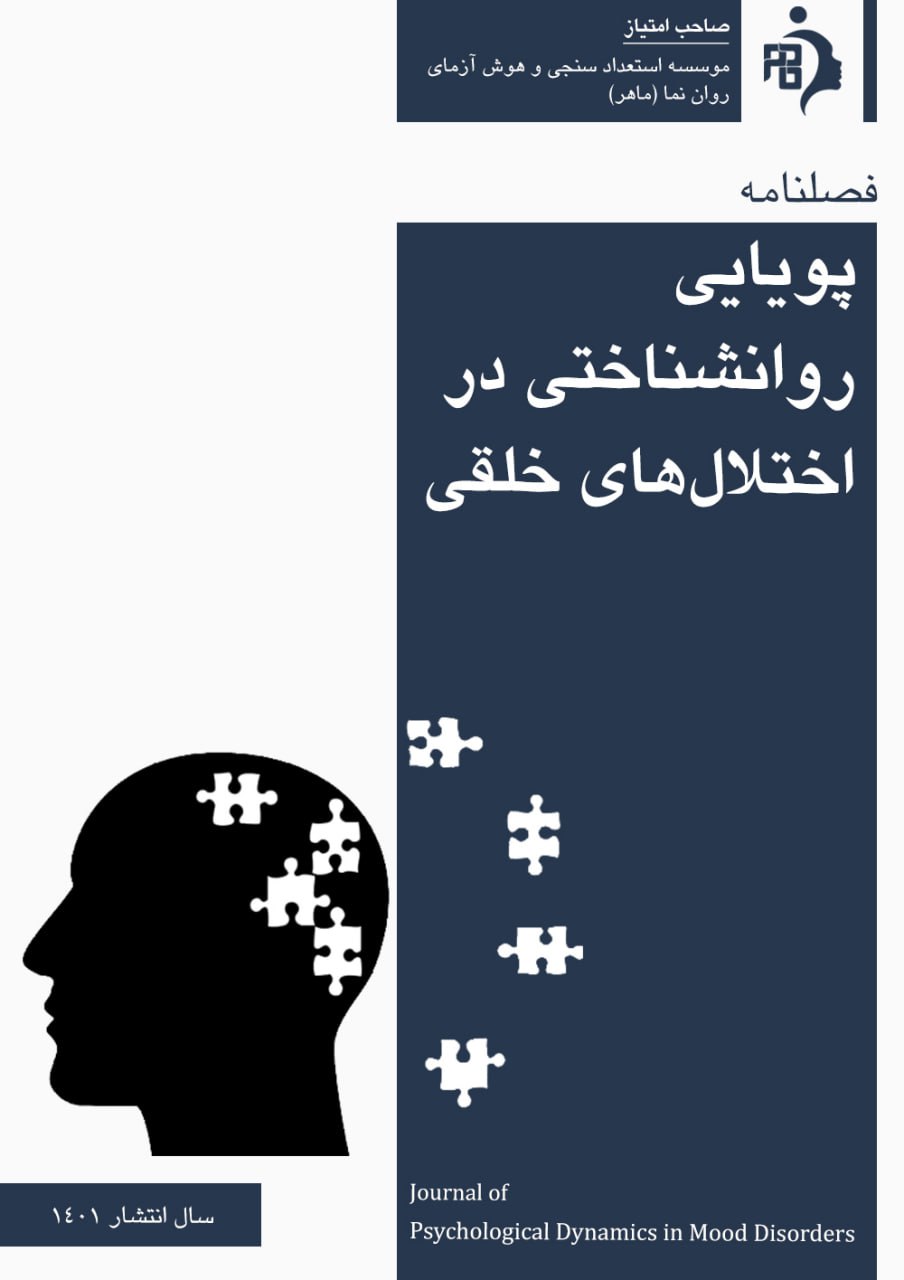مقایسه طرحوارههای هیجانی و افکار خودکشی در بیماران مبتلا به درد مزمن شدید و خفیف با و بدون پذیرش درد
کلمات کلیدی:
درد مزمن, پذیرش درد, شدت درد, طرحوارههای هیجانی, افکار خودکشیچکیده
هدف: هدف این پژوهش، مقایسه طرحوارههای هیجانی و افکار خودکشی در بیماران مبتلا به درد مزمن عضلانی و اسکلتی بر اساس شدت درد و میزان پذیرش درد بود. روششناسی: پژوهش حاضر از نوع پسرویدادی (علی–مقایسهای) بود. جامعه آماری شامل کلیه بیماران مبتلا به درد مزمن مراجعهکننده به کلینیک درد بیمارستان رسول اکرم تهران در بهار ۱۴۰۳ بود. از میان مراجعان، ۱۶۰ نفر به روش نمونهگیری هدفمند انتخاب و در چهار گروه ۴۰ نفری بر اساس شدت درد (شدید/خفیف) و میزان پذیرش درد (با پذیرش/بدون پذیرش) طبقهبندی شدند. ابزارهای مورد استفاده شامل پرسشنامه دردهای مزمن (محمدیان، ۱۳۷۴)، پرسشنامه پذیرش درد مزمن (مسگریان، ۱۳۹۰)، پرسشنامه طرحوارههای هیجانی (لیهی و همکاران، ۲۰۱۹) و مقیاس افکار خودکشی (محمدیفر و همکاران، ۱۳۹۶) بودند. دادهها با استفاده از آزمون تحلیل واریانس چندمتغیره (MANOVA) و آزمون تعقیبی بونفرونی تحلیل شدند. یافتهها: نتایج نشان داد شدت درد و پذیرش درد اثر معناداری بر افکار خودکشی و طرحوارههای هیجانی دارند (p < 0.01). بیماران دارای درد شدید و بدون پذیرش درد، نمرات بالاتری در طرحوارههای هیجانی منفی و افکار خودکشی داشتند. اثر متقابل شدت درد و پذیرش درد نیز معنادار بود؛ به این معنا که افزایش پذیرش درد در بیماران با درد شدید باعث کاهش چشمگیر افکار خودکشی و ارزیابی منفی هیجانات شد. همچنین، شیوع افکار خودکشی در گروه درد شدید و بدون پذیرش ۴۰٪ و در سایر گروهها حدود ۱۰٪ گزارش شد. نتیجهگیری: یافتهها نشان میدهد که شدت درد و میزان پذیرش درد نقش تعیینکنندهای در تنظیم هیجانی و بروز افکار خودکشی در بیماران مزمن دارند. ارتقای پذیرش درد و مداخلات شناختی–هیجانی مبتنی بر اصلاح طرحوارههای ناسازگار میتواند در کاهش افکار خودکشی و بهبود سلامت روان بیماران مبتلا به درد مزمن مؤثر باشد.
دانلودها
مراجع
Aghili, M., Hasan Nezhad, Zahar, Asghari, Arezou. (2022). The Effectiveness of Emotional Schema Therapy Group Training on Sexual Self-Concept, Emotional Maturity and Interactive Patterns of Women with Chronic Pain. The Women and Families Cultural-Educational, 17(61), 199-219. https://cwfs.ihu.ac.ir/article_207728.html?lang=en
Ahmadi, V., & Valizadeh, H. (2021). The Effectiveness of Acceptance and Commitment-Based Therapy on the Quality of Life and Death Anxiety in the Elderly. Aging Psychology, 7(2), 166-153. https://doi.org/10.22126/jap.2021.6370.1528
Bagiyan Kulehmarzi, M. J., Yaztappeh, J. S., Khanjani, S., Abasi, I., Rajabi, M., & Mojahed, A. A. (2023). Study of Early Life Experiences, Temperament, Character, and Psychological Pain in Suicide Attempters and Normal Individuals. Middle East Journal of Rehabilitation and Health Studies, 10(1). https://doi.org/10.5812/mejrh-126887
De Filippis, S., Erbuto, D., Gentili, F., Innamorati, M., Lester, D., Tatarelli, R., Martelletti, P., & Pompili, M. (2021). Mental turmoil, suicide risk, illness perception, and temperament, and their impact on quality of life in chronic daily headache. The Journal of Headache and Pain, 9(6), 349-357. https://doi.org/10.1007/s10194-008-0072-4
Farsa, F. A., Shahabizadeh, F., Hashemi, M., & Dadkhah, P. (2022). Presenting a Model of Pain Outcomes in Patients With Chronic Low Back Pain Based on Mood and Anxiety Symptoms and Emotional Schemas: The Mediating Role of Experiential Avoidance and Self-Compassion. Shenakht Journal of Psychology and Psychiatry, 9(5), 40-54. https://doi.org/10.32598/shenakht.9.5.40
Ghasemkhanloo, A., Atadokht, A., & Sabri, V. (2021). The effectiveness of emotional schema therapy on the severity of depression, emotional dysregulation and emotional schemas in patients with major depressive disorder [Research]. Shenakht Journal of Psychology and Psychiatry, 8(3), 76-88. https://doi.org/10.32598/shenakht.8.3.76
Goharrizi Zandi, G., Ghorban Jahromi, Reza, Robatmili, Somaye, Zare Bahramabadi, Mahdi. (2023). Causal Model of Pain Intensity Based on Attachment Styles Mediated by Early Maladaptive Schemas in Patients with Chronic Pain. Psychological Achievements, 30(1), 315-332. https://doi.org/10.22055/psy.2022.40920.2856
Grant, A. R., Westhorp, G., Mardon, A. K., White, M., Hibbert, P., Karran, E. L., Roeger, C., & Moseley, G. L. (2025). How Is Chronic Pain Managed in Rural Australia? A Qualitative Study Exploring Rural Healthcare Professional and Consumer Experiences. Australian Journal of Rural Health, 33(1). https://doi.org/10.1111/ajr.70000
Kamalian, T., Mirzahoseini, H., & Monirpoor, N. (2020). Comparison of the effectiveness of Emotional Schema Therapy with Self-Differentiation Method on marital burnout in women. Applied Psychology, 14(1), 9-33. https://doi.org/10.52547/apsy.14.1.9
Landi, G., Grossman-Giron, A., Bitan, D. T., Mikulincer, M., Grandi, S., & Tossani, E. (2023). Mental Pain, Psychological Distress, and Suicidal Ideation During the COVID-19 Emergency: the Moderating Role of Tolerance for Mental Pain. International journal of mental health and addiction, 21(2), 1120-1131. https://doi.org/10.1007/s11469-021-00646-4
Miller, B. T., Scheman, J., Petro, C. C., Beffa, L. R. A., Prabhu, A. S., Rosen, M. J., & Krpata, D. M. (2023). Psychological disorders in patients with chronic postoperative inguinal pain. Hernia, 27(1), 35-40. https://doi.org/10.1007/s10029-022-02662-2
Okifuji, A., & Benham, B. (2011). Suicidal and Self-Harm Behaviors in Chronic Pain Patients. Journal of Applied Biobehavioral Research, 16(2), 57-77. https://doi.org/10.1111/j.1751-9861.2011.00065.x
Rahmati, R., Taklavi, S., & Mousazadeh, T. (2021). The effects of emotional schema therapy on anger and suicidal ideation in men with extramarital relations. MEJDS, 11, 128-128. https://doi.org/10.29252/mejds.0.0.213
Ribatti, R. M., Merten, T., Lanciano, T., & Curci, A. (2025). Detecting simulated symptoms in chronic pain and fibromyalgia: A two-study evaluation of the Italian version of the Self-Report Symptom Inventory. Applied Neuropsychology: Adult, 1-9. https://doi.org/10.1080/23279095.2025.2475951
Saariaho, A., Saariaho, T., Mattila, A. K., Karukivi, M., & Joukamaa, M. (2015). Alexithymia and Early Maladaptive Schemas in Chronic Pain Patients. Scandinavian journal of psychology, 56(4), 428-437. https://doi.org/10.1111/sjop.12226
Shor, R., Borowski, S., Zelkowitz, R. L., Pineles, S. L., Copeland, L. A., Finley, E. P., Perkins, D. F., & Vogt, D. (2023). The Transition to Civilian Life: Impact of Comorbid PTSD, Chronic Pain, and Sleep Disturbance on Veterans’ Social Functioning and Suicidal Ideation. Psychological Trauma Theory Research Practice and Policy, 15(8), 1315-1323. https://doi.org/10.1037/tra0001271
Valian, S., Akbari, H., & Mirani, A. (2024). The Effectiveness of Cognitive Hypnotherapy on Subjective Pain and Guilt in Individuals With a History of Suicide. Jayps, 5(9), 8-14. https://doi.org/10.61838/kman.jayps.5.9.2
Voderholzer, U., Schwartz, C., Thiel, N., Kuelz, A. K., Hartmann, A., Scheidt, C. E., Schlegl, S., & Zeeck, A. (2013). A Comparison of Schemas, Schema Modes and Childhood Traumas in Obsessive-Compulsive Disorder, Chronic Pain Disorder and Eating Disorders. Psychopathology, 47(1), 24-31. https://doi.org/10.1159/000348484
Yousefzadeh, M., Hashemi, S. M., Talebi, H., Neshat-Doost, H., Taheri, M., & Momenzadeh, S. (2020). Compare the Effectiveness of Cognitive- Behavior Therapy and Schema Therapy on reducing the cognitive error of pain catastrophizing and increase of pain self- efficacy in Tehranian Patients with Chronic Low Back Pain. https://www.researchgate.net/publication/344187563_Compare_the_Effectiveness_of_Cognitive-_Behavior_Therapy_and_Schema_Therapy_on_reducing_the_cognitive_error_of_pain_catastrophizing_and_increase_of_pain_self-_efficacy_in_Tehranian_Patients_with_Chron
دانلود
چاپ شده
ارسال
بازنگری
پذیرش
شماره
نوع مقاله
مجوز
حق نشر 2025 ساناز سلامتی, علیرضا شکرگزار, آرزو تاری مرادی, سعید محمودینیا, معصومه ژیان باقری (Author)

این پروژه تحت مجوز بین المللی Creative Commons Attribution-NonCommercial 4.0 می باشد.









